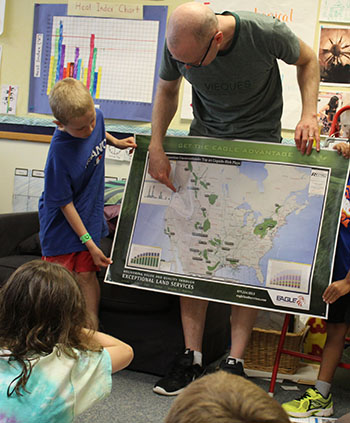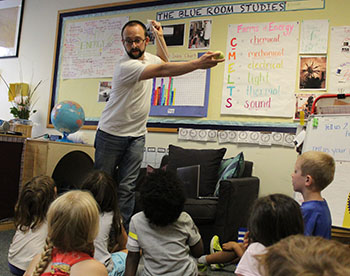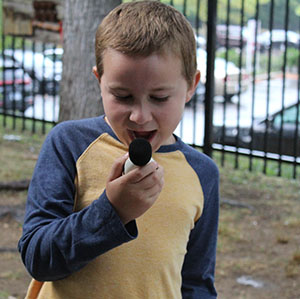
Energy! Blue Room Summer Camp 2018 |

Week Four
Potential Chemical Energy- The word potential was introduced to the children in anticipation of their field trip. Campers learned potential is stored energy. A group of children made a cake that was determined to have chemical energy involved by mixing the ingredients and cooking them. The recipe was contributed from one of the campers. More chemical experiments were researched including vinegar and baking soda reactions and a lava lamp made from oil water and Alka Seltzer.

Robots- Dr. Sarah Bergbreiter, micro-robotics expert from the mechanical engineering department at the UMD, brought some of her mini robots in to share with the children. She showed how each robot was powered by a battery who's size was determined by that of the robot. The smallest, named "Tiny Terp", had a magnet attached to make the insertion of the battery into the robot easier. The tiny little robots moved across a great room table without falling off the edge due to the way they were programed. Bergbreiter also showed the children a micro-robot that was powered with potential energy, a new word the children had been working on this week.

Back in the classroom children designed their own robot as a writing assignment. First they drew a diagram of their idea and each child was encouraged to included three types of energy that they had been learning about so far in summer camp. The following day campers shared their creations with the class.

Mechanical Energy

Another CYC Dad, Mr. Anderson, with expertise in mechanical energy, came with a few demonstrations for the children. His emphasis was on potential and kinetic energy. Mr. Anderson jumped up on the couch with a tennis ball hanging from a string to demonstrate how the ball carried stored energy when he held it at a certain angle and when he released it, it had the energy of motion, or kinetic energy. Then he stretched a rubber band to show the potential energy, that all the children were familiar with. But when he released it and it shot across the room the potential energy turned into kinetic energy. As a final example he rolled a large magnet on the table toward a smaller wheel shaped magnet. The magnets have stored energy he said, that can pull toward each other. Each child was anxious to try the experiment and later a large basket of magnets was pulled off the science shelf of the Blue Room to be explored by the children. Mr. Anderson also brought up the concept that you cannot create or destroy energy, you can only convert or transform it.

Teacher's Corner
Use whole numbers and simple, everyday fractions in ordering, counting, identifying, measuring, and describing things and experiences.

A decibel meter was available for children to explore the effects of sound. At times it was taken outside to read the different sound volumes compared to those inside the classroom. It was noted that during the fire drill the meter ran well over 100. Children are guided to note the decimal place as a fraction of a decibel and to focus on the whole number before the decimal.
F.1.1 Demonstrate understanding of the organization and basic features of print. RF.1.1.a Recognize the distinguishing features of a sentence (e.g., first word, capitalization, ending punctuation).
During the summer daily journal prompts are given to the children. The teachers check each one and guide children to remember these features.
Essential Skills and Knowledge Ability to apply knowledge of fractional wholes and halves to telling time

The schedule for the day is displayed using clocks. Children are directed to look at the display to answer questions about what is happening next and what time that will be. At times the teachers are called out on not sticking with the time schedule!
A. Scarcity and Economic
A scrap basket is provided for paper that still has some use to it. Children discussed how paper is made from trees and it is a good idea to reuse some of this paper. Tuesdays are set aside to use only recycled paper.
Children read and discussed the book, "One Plastic Bag" by Miranda Paul, to talk about how to be responsible with trash and items that are destined for the landfill. This book describes one village in Gambia that collected discarded plastic bags and crocheted them into usable purses.
Building 381, 4028 Valley Drive College Park, Maryland 20742